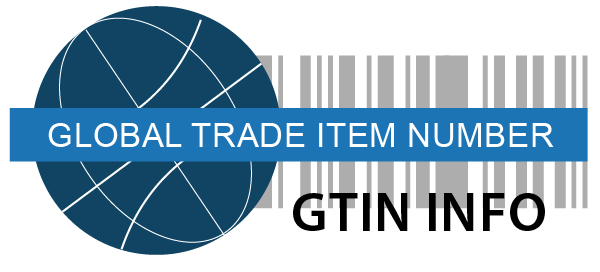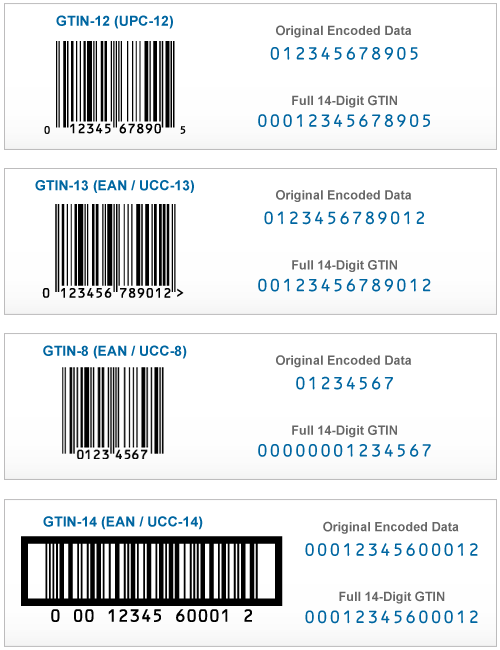The GTIN describes a family of GS1 (EAN.UCC) global data structures that employ 14 digits and can be encoded into various types of data carriers. Currently, GTIN (Global Trade Item Number) is primarily used within barcodes, but it can also be used in other data carriers such as radio frequency identification (RFID) and future GS1 Digital Link QR Codes. The GTIN is only an umbrella term to describe varying types of GS1 numbering strings. For North American companies, the UPC is an existing form of the GTIN. To obtain authentic GS1 licensed UPC barcodes, please visit www.barcode-us.com.
GTIN-12 (UPC-12)
The 12-digit number used primarily in North America. The UPC-A barcode is the common symbol used to encode GTIN-12.
GTIN-8 (EAN/UCC-8)
An 8-digit number used predominately outside of North America.
GTIN-13 (EAN/UCC-13)
A 13-digit number used predominately outside of North America.
GTIN-14 (EAN/UCC-14 or ITF-14)
A 14-digit number used to identify trade items at various packaging levels
The Barcode Languages Used To Encode GTINs
The term, symbology, is used to describe a barcode language. Today, six symbologies support GTIN data structures: UPC; EAN; ITF-14; GS1-128; and GS1 Databar, and GS1 QR Code. Of these, ITF-14, GS1-128, and GS1 Databar employ 14-digit data structures of which the first character is a packaging level indicator (i.e., item or case). Both UPC and EAN have an implied packaging level of a single item. Therefore, these symbologies support the GTIN data structure without changing the number of encoded data characters.
The table below further illustrates the relationship between GTIN, legacy terminology, symbologies and use at point of sale (POS). In most cases, the legacy terminology and the symbology are called by the same name. GTIN changes this by separating the name of the data structure from the data carrier or, in this case, the symbology.
| GTIN Data Structure | Primary Use | Legacy Terminology | Symbology | Use at POS |
|---|---|---|---|---|
| GTIN-12 | Retail Products | UPC, UCC-12 | UPC-A, UPC-E | Yes |
| GTIN-13 | Retail Products | EAN, JAN, EAN-13 | EAN-13 | Yes |
| GTIN-8 | Small items (e.g., gum) | EAN-8 | EAN-8 | Yes |
| GTIN-14 | Fresh Produce/Meat/Dairy | EAN / UCC-14 | GS1 Databar Family | Yes |
| GTIN-14 | Cases/Pallets | ITF-14, SCC-14, UPC Case Code | ITF-14 | Not Yet |
Barcode Encodation of GTIN Data Structures
The GTIN is a globally unique 14-digit number used to identify trade items, products, or services. The full 14-digit GTIN is achieved on a data carrier of shorter length by ‘padding’ the number with left-justified zeros out to 14 digits.
The illustration to the right displays how each of the GTIN data formats is encoded within common barcodes.
The Evolution of GTINs
In the early 2000s retailers had to make adjustments to their original database structures to accept GTINs with the full 14-digit data string. This was at the same time that the Uniform Code Council (UCC) merged with global EAN offices to create GS1 Global. Since the original UPC-A was only 12-digits, this resulted in a massive undertaking but opened the door for GTIN data structures to be globally accepted.
Nothing really changed in terms of the barcodes that were to be used. The UPC did not go away; GTIN is a term referring to how the data is stored, i.e., padding the item number with zeroes to a uniform length. Most scanners in use will already scan any bar code within the GTIN family. The storage of the numbers is the issue being addressed. Many larger retailers and marketplaces, such as Amazon, now use the term GTIN within their supplier requirements.
Since the inception of bar codes with the UPC more than 50 years ago, hundreds of thousands of possible number combinations have been issued as manufacturer or company prefixes. GS1 has continually changed the standards of the issuing numbers, since GS1 standards are being adopted by other industries. Due to the limitations of early technology/programming, a 2005 sunrise date was established in the early 2000’s to prepare retailers and manufacturers for the changes.
Please click here to learn about the Sunrise 2005 initiative.
GTINs: Boosting Your Online Presence
GTINs significantly boost product discoverability across Google Shopping, Amazon, and other platforms as a universal identifier. GTINs help search engines better understand, index, and display your products in relevant search results.
For e-commerce, sellers are required to include GTINs in product feeds to avoid listing rejections and maximize visibility.
How To Get Barcodes
- Estimate How Many Barcodes
- Apply at BARCODE US To Establish GTIN.cloud® account
- License UPC Company Prefix/GTINs
- Assign UPC/GTINS and Create Barcodes on GTIN.cloud®
Important Points
GTINs and Barcodes Are Not The Same
A GTIN is the actual identifier. The barcode symbol is a data carriers.
GTINs Cannot Ever Be Reused
GS1 global standards mandates that GTINs should not ever be reused.
Each Product Variant Needs a Unique GTIN
Identify your products as you would like retailers to order your products.
Use Company Licensed GTINs
Global retailers and Amazon require GS1 licensed Company Prefixes and GTINs.
We Are Here To Help!
Please contact us at 888.540.6885 or chat with us online If you would like to set up a call with a consultant for assistance, please use the button below.








